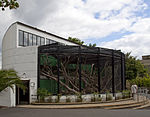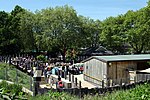St Mark's Regents Park

St. Mark's Church is located in the Borough of Camden, London, near Regent's Park on Prince Albert Road. Built in 1851-2, it was consecrated in 1853 and belongs to the Diocese of London within the Church of England. Originally designed by Thomas Little, alterations in 1888-90 were made by Arthur Blomfield, it is constructed of Kentish ragstone in the early English style.The church was destroyed during the Battle of Britain in 1940 and the restored church was consecrated in October 1957, the first completely rebuilt Anglican church in London. It is Grade II listed. The church contains stained glass (1957) depicting St Peter and St Mark by Brian Thomas. It also contains a reredos by Sir Ninian Cooper.
Excerpt from the Wikipedia article St Mark's Regents Park (License: CC BY-SA 3.0, Authors, Images).St Mark's Regents Park
St Mark's Square, London Chalk Farm (London Borough of Camden)
Geographical coordinates (GPS) Address External links Nearby Places Show on map
Geographical coordinates (GPS)
| Latitude | Longitude |
|---|---|
| N 51.5379 ° | E -0.1522 ° |
Address
Saint Mark's
St Mark's Square
NW1 7TP London, Chalk Farm (London Borough of Camden)
England, United Kingdom
Open on Google Maps







